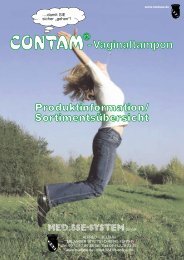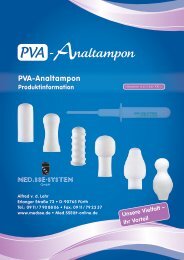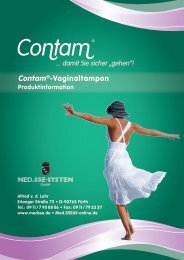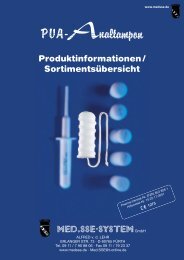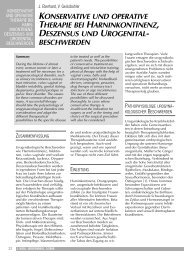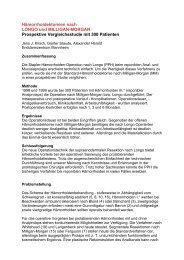Konservative Therapie von Harninkontinenz, Drangsymptomen und ...
Konservative Therapie von Harninkontinenz, Drangsymptomen und ...
Konservative Therapie von Harninkontinenz, Drangsymptomen und ...
Erfolgreiche ePaper selbst erstellen
Machen Sie aus Ihren PDF Publikationen ein blätterbares Flipbook mit unserer einzigartigen Google optimierten e-Paper Software.
adipösen Patientinnen sollte wie bei den inkontinenten Frauen<br />
eine Gewichtsreduktion angestrebt werden [39]. Bei leichtem<br />
Prolaps können Beckenbodentraining <strong>und</strong> Verhaltensmaßnahmen<br />
wie ballaststoffreiche Ernährung <strong>und</strong> Stuhlregulation<br />
zur Vermeidung der Bauchpresse bei chronischer Obstipation<br />
eingesetzt werden, um ein Fortschreiten der Symptome zu<br />
verringern. Physiotherapie erhöht den Tonus der Beckenbodenmuskulatur,<br />
welche die Organe des kleinen Beckens<br />
trägt <strong>und</strong> stützt. Für den symptomatischen Deszensus gibt es<br />
jedoch nicht genügend Evidenz für die physiotherapeutische<br />
Beckenbodenrehabilitation [39]. Dennoch ist diese <strong>Therapie</strong><br />
bei Frauen mit leichten Deszensusformen als Anfangstherapie<br />
beliebt. Eine weitere Alternative zur operativen <strong>Therapie</strong> ist<br />
die seit Jahrh<strong>und</strong>erten bekannte Pessartherapie (Abb. 1d, e).<br />
Sie kann bei nicht operablen Patientinnen, schwerer Komorbidität,<br />
Rezidivdeszensus, positivem Kinderwunsch, in der<br />
Schwangerschaft <strong>und</strong> bei Wunsch nach nicht operativer <strong>Therapie</strong><br />
angewandt werden [40]. Um Ulzerationen vorzubeugen,<br />
werden Pessare mit Östriolcremen eingeführt. Östriol verbessert<br />
die Vaskularisation der Vaginalhaut <strong>und</strong> unterstützt die<br />
Bildung kollagener Fasern, wodurch die Elastizität des Gewebes<br />
zunimmt. Die Größe des Pessares (Würfelpessar) wird<br />
nach der Introitusweite gewählt, die mit der Anzahl passierbarer<br />
Querfinger geschätzt wird. Das Pessar wird über das Perineum<br />
eingeführt <strong>und</strong> soll über die Levatorenschenkel zu liegen<br />
kommen. Die Patientin darf in stehender Position kein<br />
Fremdkörpergefühl haben. Würfelpessare werden in der Regel<br />
morgens <strong>von</strong> der Patientin selber eingeführt <strong>und</strong> werden<br />
über Nacht entfernt; Ring- oder Siebschalenpessare können<br />
bei betagten Patientinnen bis zu sechs Wochen belassen werden.<br />
Bei mehrwöchig eingelegten Pessaren empfiehlt sich<br />
zur Geruchsminderung, verursacht durch anaerobe Bakterien,<br />
bei der Einlage die Applikation einer clindamycinhaltigen<br />
Crème, z. B. Dalacin V 2 % ® .<br />
Die Patientinnenakzeptanz der Pessartherapie ist in der Studie<br />
<strong>von</strong> Clemons mit 73 % gut [41] <strong>und</strong> abhängig <strong>von</strong> der individuellen<br />
<strong>und</strong> kompetenten Patientinneninstruktion. Eine kurze<br />
Vagina (< 6 cm), wie sie oft nach Operation gesehen wird<br />
[42], zusätzliche <strong>Harninkontinenz</strong> <strong>und</strong> ein mehr als vier Querfinger<br />
breiter Introitus sind prognostisch ungünstig für die<br />
Patientinnenzufriedenheit <strong>und</strong> die Dauer der Anwendung.<br />
<strong>Harninkontinenz</strong>, Drangsymptome <strong>und</strong> Deszensus sind multifaktorielle<br />
Krankheitsbilder <strong>und</strong> benötigen für den individuellen<br />
Behandlungserfolg ganzheitliche <strong>Therapie</strong>ansätze, den<br />
Einbezug der Lebensumstände der Patientin sowie Ausdauer<br />
<strong>und</strong> Motivation <strong>von</strong>seiten der Betroffenen <strong>und</strong> des <strong>Therapie</strong>teams.<br />
Die konservativen <strong>Therapie</strong>n sollten der Patientin als<br />
primäre Behandlungsoptionen bekannt <strong>und</strong> vor operativer<br />
<strong>Therapie</strong> ausgeschöpft sein.<br />
Literatur:<br />
1. Nygaard IE, Thompson FL, Svengalis SL,<br />
Albright JP. Urinary incontinence in elite<br />
nulliparous athletes. Obstet Gynecol 1994;<br />
84: 183–7.<br />
2. Abrams P, Cardozo L, Fall M, Griffiths D,<br />
Rosier P, Ulmstein U, van Kerrebroeck P, Victor<br />
A, Wein A. The standardisation of terminology<br />
of lower urinary tract function: report<br />
from the Standardisation Sub-committee of<br />
the International Continence Society.<br />
Neurourol Urodyn 2002; 21: 167–78.<br />
3. Fantl J, Newman D, Colling J, DeLancey<br />
JOL, Keeys C, Loughery R, et al. Urinary incontinence<br />
in aldults: acute and chronic<br />
management. Clinical Practice Guideline 96-<br />
0682, 2nd update. Department of Health and<br />
Human Services, Public Health Service,<br />
Agency for Health Care Policy and Research,<br />
Rockville, Maryland, 1996.<br />
<strong>Therapie</strong> <strong>von</strong> <strong>Harninkontinenz</strong>, <strong>Drangsymptomen</strong> <strong>und</strong> Genitaldeszensus<br />
����� Relevanz für die Praxis<br />
– Die konservative <strong>Therapie</strong> der Belastungsinkontinenz<br />
basiert primär auf der Beckenbodenphysiotherapie,<br />
welche gute Erfolgsraten zeigt. Falls die konservative<br />
<strong>Therapie</strong> nicht den gewünschten Erfolg bringt, können<br />
mit der retropubischen oder transobturatorischen Schlingeneinlage<br />
sehr gute Resultate erzielt werden.<br />
– Gute Evidenz in der <strong>Therapie</strong> der Drangbeschwerden<br />
gibt es für die Verhaltenstherapie, für das Beckenbodentraining<br />
<strong>und</strong> die medikamentöse <strong>Therapie</strong> mit Anticholinergika.<br />
– In der konservativen <strong>Therapie</strong> des symptomatischen<br />
Genitaldeszensus haben Pessare eine lange Tradition.<br />
Für ein ausgewähltes Patientinnenkollektiv wie betagte<br />
Frauen oder Frauen mit Kinderwunsch können sie die<br />
<strong>Therapie</strong> der Wahl sein.<br />
4. Hannestad YS, Rortveit G, Sandvik H,<br />
Hunskaar S. A community-based epidemiological<br />
survey of female urinary incontinence:<br />
The Norwegian EPICONT Study. J Clin<br />
Epidemiol 2000; 53: 1150–7.<br />
5. Farrell SA, Allen VM, Baskett TF. Parturition<br />
and urinary incontinence in primiparas.<br />
Obstet Gynecol 2001; 97: 350–6.<br />
6. Swift S, Woodman P, O’Boyle A, Kahn M,<br />
Valley M, Bland D, Wang W, Schaffer J. Pelvic<br />
Organ Support Study (POSST): the distribution,<br />
clinical definition, and epidemiologic<br />
condition of pelvic organ support defects.<br />
Am J Obstet Gynecol 2005; 192: 795–806.<br />
7. Olsen AL, Smith VJ, Bergstrom JO,<br />
Colling JC, Clark AL. Epidemiology of surgically<br />
managed pelvic organ prolapse and<br />
urinary incontinence. Obstet Gynecol 1997;<br />
89: 501–6.<br />
8. Urinary incontinence – the management<br />
of urinary incontinence in women. National<br />
Collaborating Centre for Women’s and Children’s<br />
Health. Commissioned by the National<br />
Institute for Health and Clinical Excellence,<br />
2006.<br />
9. Miller JM, Ashton-Miller JA, DeLancey<br />
JO. A pelvic muscle precontraction can reduce<br />
cough-related urine loss in selected<br />
women with mild SUI. J Am Geriatr Soc<br />
1998; 46: 870–4.<br />
10. Hay-Smith EJC, Dumoulin C. Pelvic floor<br />
muscle training versus no treatment, or inactive<br />
control treatments, for urinary incontinence<br />
in women. Cochrane Database Syst<br />
Rev 2006; 25: CD005654.<br />
11. Cammu H, van Nylen M, Amy JJ. A 10year<br />
follow-up after Kegel pelvic floor muscle<br />
exercises for genuine stress incontinence.<br />
BJU Int 2000; 85: 655–8.<br />
12. Bump RC, Hurt WG, Fantl JA, Wyman JF.<br />
Assessment of Kegel pelvic muscle exercise<br />
performance after brief verbal instruction.<br />
Am J Obstet Gynecol 1991; 156: 322–7.<br />
13. Bø K, Talseth T, Holme I. Single blind,<br />
randomised controlled trial of pelvic floor<br />
exercises, electrical stimulation, vaginal<br />
cones, and no treatment in management of<br />
genuine stress incontinence in women. BMJ<br />
1999; 318: 487–93.<br />
14. Wilson PD, Hay-Smith J, Nygaard I,<br />
Wyman J, Yamanishi T, Berghmans B, Hagen<br />
S, Singlair L, Moor K, Dorey G. Adult conservative<br />
management. In: Abrams P, Cardozo L,<br />
Khoury S, Wein A (eds). 3rd International<br />
Consultation on Incontinence. Recommendations<br />
of the International Scientific Commit-<br />
tee. Health Publication Ltd, Plymouth, UK,<br />
2005; 864–85.<br />
15. Laycock J, Brown J, Cusack C, Green S,<br />
Jerwood D, Mann K, McLachlan Z, Schofield<br />
A. Pelvic floor reeducation for stress incontinence:<br />
comparing three methods. Br J Community<br />
Nurs 2001; 6: 230–7.<br />
16. Parkkinen A, Karjalainen E, Vartianinen<br />
M, Penttinen J. Physiotherapy for female<br />
stress urinary incontinence: individual<br />
therapy at the outpatient clinic versus<br />
home-based pelvic floor training: a 5-year<br />
follow-up study. Neurourol Urodyn 2004; 23:<br />
643–8.<br />
17. Neumann PB, Grimmer KA, Deenadayalan<br />
Y. Pelvic floor muscle training and adjunctive<br />
therapies for the treatment of stress<br />
urinary incontinence in women: a systematic<br />
review. BMC Womens Health 2006; 28: 6–11.<br />
18. J<strong>und</strong>t K, Kiening M, Fischer P, Bergauer<br />
F, Rauch E, Janni W, Peschers U, Dimpfl T.<br />
Is the histomorphological concept of the<br />
female pelvic floor and its changes due to<br />
age and vaginal delivery correct? Neurourol<br />
Urodyn 2005; 24: 44–50.<br />
19. Subak L, Whitcom E, Shen H. Weight<br />
loss: a novel and effective treatment for urinary<br />
incontinence. J Urol 2005; 174: 190–5.<br />
20. Ross S, Viereck V. Innovation in der<br />
Stressinkontinenztherapie. Gynäkol<br />
Geburtsh 2005; 4: 43–5.<br />
21. Bhatia NN, Bergman A, Gunning JE.<br />
Urodynamic effects of a vaginal pessary in<br />
women with stress urinary incontinence. Am<br />
J Obstet Gynecol 1983; 147: 876–84.<br />
22. Dmochowski RR, Miklos JR, Norton PA,<br />
Zinner NR, Yalcin I, Bump RC; Duloxetine<br />
Urinary Incontinence Study Group.<br />
Duloxetine versus placebo for the treatment<br />
of North American women with stress urinary<br />
incontinence. J Urol 2003; 170: 1259–<br />
63.<br />
23. Mariappan P, Alhasso A, Ballantyne Z,<br />
Grant A, N’Dow J. Duloxetine, a serotonin<br />
and noradrenaline reuptake inhibitor (SNRI)<br />
for the treatment of stress urinary incontinence:<br />
a systematic review. Eur Urol 2007;<br />
51: 67–74.<br />
24. Milsom I, Abrams P, Cardozo L, Roberts<br />
RG, Thüroff J, Wein AJ. How widespread<br />
are the symptoms of an overactive bladder<br />
and how are they managed? A populationbased<br />
prevalence study. BJU Int 2001; 87:<br />
760–6.<br />
25. Burgio KL, Locher JL, Goode PS, Hardin<br />
JM, McDowell BJ, Dombrowski M, Candib<br />
J UROL UROGYNÄKOL 2008; 15 (3)<br />
29



